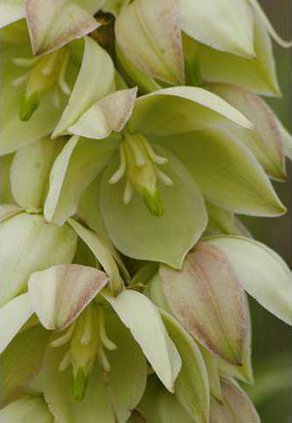Dotting Cheyenne Bottoms’ sand hills, the stately yucca plant is blooming, beginning an elaborate partnership of survival between animal and plant. Towering spikes of bell-like flowers emit a pleasant fragrance, attracting a small bright white moth, commonly named the yucca moth. Over millions of years, plant and moth formed a relationship, making each essential to the other’s survival – the moth’s young only eat yucca and no other pollinator visits the yucca’s flowers.
Seeking a male, the one-quarter inch long yucca moth finds a male partner on the yucca plant during the day, an exception to the rule of moths flying at night. She mates and begins the process of ensuring the survival of her young. The flower’s pollen structures, the stamens, now draw her attention. Using two tentacle-like modified mouth structures, she sets about gathering pollen from the yucca’s stamens, scraping pollen into a ball she carries beneath her head. With no eating mouth parts, she lives only a few days, her sole purpose mating and laying eggs for the next generation.
Taking flight, she searches the hillside for other yucca plant flowers, carrying her precious cargo. Not just any yucca flower is acceptable. She needs yucca blossoms that have not yet been pollinated by another yucca moth, normally a newly-opened flower. Sensing the pheromone, a chemical scent, left by other female yucca moths after they visit the flower, she searches for an untouched flower. This all important search ensures the survival of her young and the yucca’s seeds. Too many eggs laid within the flower’s ovary and the flower aborts.
Tasting the yucca blossoms with her delicate feet, she finds a virgin flower. Walking into the flower’s depth, she makes a hole in the ovary, laying 5 to ten eggs, allowing enough seed for caterpillar food and seed dispersal and germination. After marking the flower with her pheromone, she scrapes some pollen from her supply, applying it to the flower’s stigma, actively guaranteeing the flower’s pollination. The stigma is the flower’s receptacle for pollen, from which the pollen grains form a tube, allowing the pollen grain to travel to the ovary and join with an ovule to form a seed.
After repeating the whole process over a few more days, exhausting her egg supply, her life is done. Her caterpillars hatch within the yucca ovaries, eating seeds until it is time for them to pupate and form a cocoon. Dropping to the ground, they burrow into the soil where they await spring’s warm temperatures to heat the soil, prompting their emergence into adulthood.
Both species have become so specialized they rely on one another for their survival, forming a vital relationship to which both are totally devoted. Unlike the narrow-mouth toad and the Texas brown tarantula that assist each other by convenience but that’s another story for another day!
The Wetland Explorer - Forming relationships





